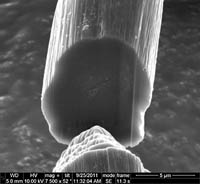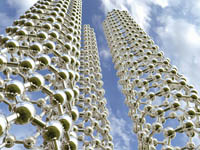Carrying an elevator into space requires a special kind of cable. For a start, it would need to be exceptionally long, extending for 110,000km from the surface of the Earth – around a third of the way to the Moon – and it would need to be both very light and very strong to have a chance of supporting its own weight. It would also ideally need to be superconducting; this would allow the elevator to travel to and from an orbiting space station without actually touching the cable, thereby reducing friction.
Perhaps surprisingly, there is a material that meets all these requirements and so could form the basis for such a cable, at least theoretically; and that material is the carbon nanotube (CNT) – carbon atoms wrapped up in a tube. With a tensile strength of 100GPa (gigapascal), CNTs are around 100 times stronger than steel while only weighing around a sixth as much. What is more, they can conduct electricity more efficiently than copper wires.
With these impressive properties, CNTs could also find a whole host of more Earth-bound applications. They could make highly efficient power and data cables, flexible electrodes for batteries, strong medical fabrics and tough protective clothing such as body armour.
As with the space elevator, though, these applications are all theoretical at the moment. The impressive properties have only been measured in individual CNTs, which are 1–20nm wide and extend for only a few centimetres at most. When individual tubes are joined together, the resultant fibres possess much less impressive properties.
The challenges
There are several reasons why CNT fibres do not perform as well as individual CNTs. For optimum performance, the CNTs in the fibres need to be free of defects and all aligned in the same direction. They also need to be as long as possible, to reduce the number of individual CNTs making up the fibre, and they need to be fixed in place to stop them sliding past each other.
At the moment, scientists struggle to produce fibres with these desirable qualities. Furthermore, in order to fabricate a 110,000km-long space cable, or just a power cable, they would need to be able to produce them on an industrial scale and that is even more of a challenge.
The world record for the strongest CNT fibre is currently held by a team of British and US chemists. In 2007, they produced a 1mm-long CNT fibre with a strength of almost 9GPa, making it much stronger than commercially-available high-strength fibres such as Kevlar (Science, 2007, 318, 1892).
This fibre was so strong because the component CNTs were themselves around 1mm long. The strength rapidly dropped when the CNTs were combined into longer fibres, with a 2cm-long fibre displaying a strength of around 2GPa. In addition, the chemists produced this fibre by spinning it directly from CNTs as they formed by chemical vapour deposition (CVD). This is a very slow process and couldn’t be used to produce CNT fibres on an industrial scale.
By focusing on some of the other desirable properties, scientists are now exploring alternative ways for producing strong, electrically-conducting CNT fibres that do offer the potential for scale up. Some of them have even found companies to undertake this scale up.

Matteo Pasquali Rice University in Houston, US
Commercial interest
Horacio Espinosa and his colleagues at Northwestern University in Illinois, US, are experimenting with ways to prevent individual CNTs from sliding past each other, which greatly reduces the strength of the fibre. On the other hand, the CNTs shouldn’t be to be too inflexible, otherwise the fibre will be brittle and prone to snapping. The CNTs need to stay in place, but also need to bend a little.
To produce such a fibre, Espinosa followed a template set by strong and tough natural fibres, such as spider silk, in which stiff, rigid proteins are linked together by flexible proteins and a reconfigurable network of hydrogen bonds. ‘We take a biologically-inspired approach toward designing high-performance CNT-based yarns, by incorporating a dissipation mechanism utilised in nature into our CNT yarns,’ explains Espinosa.
Espinosa’s fibres are made from bundles of CNTs fabricated commercially by the US technology company MER Corporation. These bundles, which each contain a few tens of CNTs and are a few tens of nanometres in diameter, are produced in the form of mats via CVD. Espinosa cuts ribbons from these mats, sprays polyvinyl alcohol (PVA) onto the ribbons and then twists them into fibres.
As a result, the PVA becomes incorporated within the fibre, where it links together the individual CNT bundles. This process is aided by the fact that the CNT bundle fabrication process leaves the bundles covered in acrylic acids and esters, which the PVA then binds with via hydrogen bonds. In this way, the PVA essentially glues the CNT bundles together, preventing them sliding past each other and thus enhancing the strength of the fibre. In addition, the hydrogen bonds between the PVA and the bundles are able to break and reform, allowing the fibre to bend and deform without being damaged, enhancing its toughness.
Testing 16mm-long sections of this CNT fibre, Espinosa found it had a strength of 0.77GPa (ACS Nano, 2013, 7, 3434). While this is still a long way behind the strength of the current world record holder, Espinosa is exploring various ways to increase the fibre’s strength. This includes aligning all the CNT bundles in the same direction, because at the moment they are randomly oriented.
Nevertheless, these fibres are already on the way to being commercialised, with MER Corporation currently scaling up production. Espinosa envisages these fibres primarily being used to produce tough fabrics. ‘In particular, due to their high energy absorption per unit weight, [they] could act as an energy absorption component in body armour,’ he says.
Equally close to commercialisation are CNT fibres developed by a team led by Matteo Pasquali at Rice University in Houston, US. Helping to smooth the path to commercialisation is the fact that these fibres, which consist entirely of CNTs, are produced by using wet-spinning, a process that is already employed to manufacture tough fibres such as Kevlar on an industrial scale.
Wet spinning involves dissolving the component parts of the fibre, in this case CNTs, in a solution and then forcing it through small holes known as spinnerets. This process not only squeezes out all the solvent, causing the CNTs to pack tightly together into a fibre, but also aligns all the CNTs in a similar direction, helping to enhance the fibre’s strength. One major stumbling block has been finding an effective solvent for CNTs, but Pasquali came up with a solution in 2009 with chlorosulfonic acid, which is still the only known CNT solvent.
The other problem is that wet spinning has traditionally been restricted to fairly short CNT fibres, around 0.5μm in length. Now, however, Pasquali and his colleagues have developed a version of wet spinning that works with CNTs up to 5μm in length. ‘Our process gives the most packed and aligned fibers made to date, which leads to the best properties attained so far,’ he says.
The CNT fibres made using this wet spinning process have a tensile strength of around 1GPa, making them 10 times stronger than previous wet-spun CNT fibres (Science, 2013, 339, 182). They also have very high electrical and thermal conductivities; however, Pasquali thinks there is a lot of scope for increasing this strength, by using even longer CNTs.
Pasquali has already shown that two of his CNT fibres can support a light emitting diode and supply it with power, whereas similar copper wires would break. He is now exploring various other applications: ‘We [have] started exploring applications of the fibres to various areas, including aerospace electronics, sound systems, conductive textiles and biomedical applications.’
Meanwhile, the Dutch industrial fibre company Teijin Aramid is looking to commercialise the fibre. The company already uses wet spinning to produce tough fibres such as Twaron and helped Pasquali develop his wet spinning process. It is currently testing the fibres with some of its customers and so far the reactions have been positive. ‘We will scale up if there is a good business opportunity,’ says a spokesperson for the company.

Additional potential
Other research groups are not content with the impressive properties that CNTs already posses and want to produce CNT fibres with additional abilities. One way to do this is to incorporate a range of other materials into the CNT fibre. Ray Baughman and his colleagues at the University of Texas at Dallas, US, have come up with a way to do this.
Their method involves first pulling a sheet from a thick array of CNTs, known as a CNT forest, in much the same way that a silk thread is pulled from a cocoon. Next, some liquid or powder is sprayed onto the CNT sheet, before it is twisted into a fibre. In this way, the liquid or powder becomes naturally incorporated into the fibre, comprising up to 95% of its weight.
For example, incorporating a mixture of magnesium and boron powders into these fibres causes them to become superconducting at low temperatures, which would be ideal for a space elevator cable (Science, 2011, 331, 51). By incorporating paraffin wax, which expands on heating, into the fibres, Baughman recently produced artificial muscles that repeatedly expand and contract in response to changes in temperature (Science, 2012, 338, 928). Such fibres could also be incorporated into fabrics to produce clothing that becomes more porous as it gets hotter, automatically cooling the wearer; Baughman is already in discussions with various textile and clothing manufacturers.
One of the other advantages of this method is that it can work with longer CNTs than wet spinning. ‘We can spin CNTs that are about 3mm long from a CNT forest, while the nanotubes that people are conventionally spinning from solution are much less than a micron,’ says Baughman. The resultant fibres have a tensile strength of around 0.5GPa. The goal now, says Baughman, is to spin CNTs with narrower diameters, which would increase the strength of the fibres: ‘This issue of aspect ratio is a key one for our solid-state processing.’
The graphene option
CNTs are not the only option. Scientists such as Shu-Hong Yu at the University of Science and Technology of China in Hefei are producing similar fibres from graphene, a one-atom thick layer of carbon atoms. Graphene is basically what would you would get if you snipped a CNT up the middle and laid it down flat.
To create their fibres, Yu and his colleagues simply immerse sheets of graphene oxide, which are graphene sheets covered in oxygen atoms, in a solution of an organic solvent – hexadecyltrimethylammonium bromide (CTAB). They use graphene oxide because the oxygen atoms cause the sheets to disperse better in the solvent. Once dispersed, the graphene sheets first stick together and then curl up into fibres, which can simply be pulled from the solution. Finally, a reducing agent is used to remove the oxygen atoms, producing graphene fibres more than 10cm long with a tensile strength of 0.18GPa (Scientific Reports, 2012, 2, 613).
Although they aren’t as strong as CNT fibres, these graphene fibres can conduct electricity just as well. They are also easier and potentially cheaper to produce than CNT fibres, which is a plus point when considering commercialisation. ‘High costs of the initial super-aligned CNT arrays or extremely rigorous conditions, such as high temperature and caustic media for CNT dispersions, are involved in preparation of CNT fibres,’ says Yu. ‘Compared with the limited conditions for CNT fibres, in our work the graphene oxide fibres were fabricated by a facile and mild wet-spinning method.’
If progress with these CNT and graphene fibres continues, the sky may very well not be the limit.
Jon Evans is a freelance science writer based in Chichester, UK





